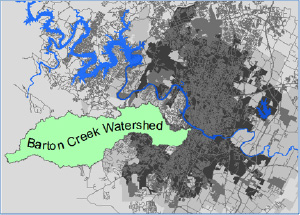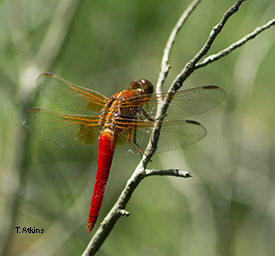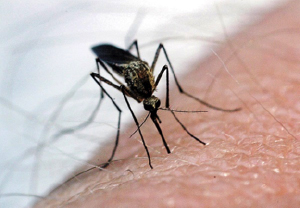Our Department gets calls from concerned community members about unusual colors seen in creeks. Some of these vibrant colors are natural, so here’s a quick guide to help identify some of the possible sources that cause these unusual sights.
Our environmental scientists encounter a lot of strange and colorful things in our creeks. Orange slime, purple fluffy goo, and rainbow sheens on the water would all appear to be pollution problems, but often it is just a natural phenomenon. Each of these things can be harmless bacteria just doing what they normally do, which is abnormally fascinating. If you suspect what you are seeing is not naturally occurring and a pollution source…
With a healthy creek here and a dirty creek there, how do we measure creek health? The Environmental Integrity Index (EII) is a program designed to continuously monitor and assess the water quality of Austin’s creeks and streams.
Austin’s creeks once ran clear in the wilderness, but now they run through the wilds of the city, picking up pollution and absorbing runoff from impervious cover and heavy rain storms. In order to understand how these urban challenges affect our creeks and develop policies that can protect them, the City of Austin uses a program called the Environmental Integrity Index (EII).
…
 The water quality of the Barton Creek Watershed is the best in Austin as evaluated by the 2015 Environmental Integrity Index. Where does your creek stand?
The water quality of the Barton Creek Watershed is the best in Austin as evaluated by the 2015 Environmental Integrity Index. Where does your creek stand?
Ladies and Gentlemen, please put your hands together for the 2015 Watershed Winner of the Environmental Integrity Index……Barton Creek!
This was a to…
This blog was updated in May 2019.
Highly destructive zebra mussels have invaded many popular Central Texas waters, and Austin’s local creeks and Barton Springs Pool are now at risk. Zebra mussels destroy local aquatic ecosystems and hurt visitors (including cutting people’s feet and dogs’ paws). In Barton Springs Pool, an infestation also would likely significantly increase maintenance costs.
Spread the Message, Not the Mussels
People can easily spread this invasive species from one body of water to another without knowing it. Young zebra mussels are invisible to the naked eye, and millions of them can live undetected on wet items for da…
 Spotted! This Neon Skimmer (Libellula croceipennis) was spotted here in Austin! A native to Texas, the neon skimmer can also be found around the Southwest including Arizona and Southern California. Known for its vivid red color and unusual mating patterns, skimmers are often seen hanging out around lakes and ponds in Central Texas. Their mating ritual is quite e…
Spotted! This Neon Skimmer (Libellula croceipennis) was spotted here in Austin! A native to Texas, the neon skimmer can also be found around the Southwest including Arizona and Southern California. Known for its vivid red color and unusual mating patterns, skimmers are often seen hanging out around lakes and ponds in Central Texas. Their mating ritual is quite e…
 Mosquitos are in your face again. Every year around this time a few citizens reach out to the Surface Water Team of the Watershed Protection Department because they think that droves of mosquitoes are emerging from the neighborhood creek or pond. City environmental scientists have found that this has not yet been true and that the real story is much more insidious.
Mosquitos are in your face again. Every year around this time a few citizens reach out to the Surface Water Team of the Watershed Protection Department because they think that droves of mosquitoes are emerging from the neighborhood creek or pond. City environmental scientists have found that this has not yet been true and that the real story is much more insidious.
Let’s start with the lowly mosquito, a little fly (Mosquito is Spanish for “l…
You may have heard the term “rain garden”, but many people don’t know what a rain garden looks like or how they can help restore our creeks. Basically, a rain garden is a shallow depression in the ground that collects water during a rain storm. The water that collects in rain gardens soaks into the soil and eventually makes its way to our rivers and streams as “base flow”. Without rain gardens the water from a storm would flow off impervious surfaces like roofs, driveways, streets and parking lots directly into the creek all at once. This can be very bad news for our streams, because that big slug of dirty stormwater causes…

